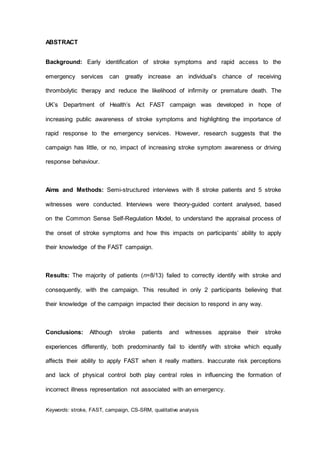Recommended
Enrolling Patients for a Behavioral Support Trial to Reduce 4.23.10

Enrolling Patients for a Behavioral Support Trial to Reduce 4.23.10Leonard Davis Institute of Health Economics
Recommended
Enrolling Patients for a Behavioral Support Trial to Reduce 4.23.10

Enrolling Patients for a Behavioral Support Trial to Reduce 4.23.10Leonard Davis Institute of Health Economics
The healthy heart study: using online and mobile risk calculators to improve ...

The healthy heart study: using online and mobile risk calculators to improve ...Charles Perkins Centre, University of Sydney
More Related Content
What's hot
The healthy heart study: using online and mobile risk calculators to improve ...

The healthy heart study: using online and mobile risk calculators to improve ...Charles Perkins Centre, University of Sydney
What's hot (17)
Detecting breathlessness and structured assessment in primary care

Detecting breathlessness and structured assessment in primary care
Incorporating the Patient Voice to Improve Ulcerative Colitis Recruitment Cas...

Incorporating the Patient Voice to Improve Ulcerative Colitis Recruitment Cas...
Leicester CLRN Meeting 'Making it real' 19 June 2013

Leicester CLRN Meeting 'Making it real' 19 June 2013
Barry Egan - Public Attitudes towards clinical research - 2009

Barry Egan - Public Attitudes towards clinical research - 2009
MedicalResearch.com: Medical Research Exclusive Interviews December 31 2014

MedicalResearch.com: Medical Research Exclusive Interviews December 31 2014
The healthy heart study: using online and mobile risk calculators to improve ...

The healthy heart study: using online and mobile risk calculators to improve ...
Similar to Abstract
Similar to Abstract (20)
Conducting behavioral-intervention-research-rural-communities-nhc-16-101

Conducting behavioral-intervention-research-rural-communities-nhc-16-101
American Journal of Emergency & Critical Care Medicine

American Journal of Emergency & Critical Care Medicine
Reducing Stroke Readmissions in Acute Care Setting.docx

Reducing Stroke Readmissions in Acute Care Setting.docx
Learning from marketing rapid development of medication messages that engage...

Learning from marketing rapid development of medication messages that engage...
V O L U M E 3 4 - N U M B E R 4 - F A L L 2 0 1 6 187FEATURE ART.docx

V O L U M E 3 4 - N U M B E R 4 - F A L L 2 0 1 6 187FEATURE ART.docx
Description This is a continuation of the health promotion pro.docx

Description This is a continuation of the health promotion pro.docx
Providing additional information aboutthe benefits of statin.docx

Providing additional information aboutthe benefits of statin.docx
The Impact of Patients’ Disease-Labels on Disease Experience Living Longer ...

The Impact of Patients’ Disease-Labels on Disease Experience Living Longer ...
The Impact of Patients’ Disease-Labels on Disease Experience Living Longer ...

The Impact of Patients’ Disease-Labels on Disease Experience Living Longer ...
Abstract
- 1. ABSTRACT Background: Early identification of stroke symptoms and rapid access to the emergency services can greatly increase an individual’s chance of receiving thrombolytic therapy and reduce the likelihood of infirmity or premature death. The UK’s Department of Health’s Act FAST campaign was developed in hope of increasing public awareness of stroke symptoms and highlighting the importance of rapid response to the emergency services. However, research suggests that the campaign has little, or no, impact of increasing stroke symptom awareness or driving response behaviour. Aims and Methods: Semi-structured interviews with 8 stroke patients and 5 stroke witnesses were conducted. Interviews were theory-guided content analysed, based on the Common Sense Self-Regulation Model, to understand the appraisal process of the onset of stroke symptoms and how this impacts on participants’ ability to apply their knowledge of the FAST campaign. Results: The majority of patients (n=8/13) failed to correctly identify with stroke and consequently, with the campaign. This resulted in only 2 participants believing that their knowledge of the campaign impacted their decision to respond in any way. Conclusions: Although stroke patients and witnesses appraise their stroke experiences differently, both predominantly fail to identify with stroke which equally affects their ability to apply FAST when it really matters. Inaccurate risk perceptions and lack of physical control both play central roles in influencing the formation of incorrect illness representation not associated with an emergency. Keywords: stroke, FAST, campaign, CS-SRM, qualitative analysis
